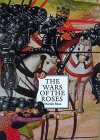House of York
Edward IV 1461 70, 71 83
1455 - 87
- Wars of the Roses between the House of York and the House of Lancaster

1476
- William Caxton, the First English Printer
Edward V 1483
- Edward not crowned
Richard III 1452 - 85
- Richard III was probably responsible for the murder of the 2 young princes in the Tower of London.
- Made famous by Shakespeare'2 play, and Sir Lawrence Olivier in the film as the hunchback king., which he was not. But he did have a sideways spinal curvature
- The last English king to die on the battlefield, at the battle of Bosworth 1855. The last battle of the War of the Roses.
House of Tudor
Henry VII 1485 1509
- Henry VII defeated Richard III at the battle of Bosworth. Not really a legitimate heir to the throne, made legitimate by his marriage to Elizabeth a descendent of William the conqueror.
Henry VIII 1509 47, 6 wives
- King Henry VIII desperately wanted a male heir to the throne and thus started the saga of his 6 wives, the break away from the Catholic religion and Henry setting himself head of the Church of England, and later the dissolution of the monasteries
16th-century
- Wool processing takes off in West Yorkshire and the population of Leeds increases to around 3000 towards the end of the century
16 17th-century
- Buildings in Briggate were half timbered jettied houses. These were replaced from the 17th-century onwards to brick built cloth merchants houses.
- The best surviving examples are in Queens Court , Now location of the Queens Court & Fibre Bars. and Lamberts yard. The latter is now private flats with a gate preventing entry.
- It well worth having a quick look up the various courts off Lower Briggate and Briggate to see the emerging building that has started to take place.
- The Whip Inn yard, the Angel yard, and the Ship Inn yard are all worth a visit. Note the council run guided tours of these courts.
1534
- John Leyland, later to become antiquary to King Henry VIII, made a tour through England and wrote of Leeds: ‘Miles lower than Christal Abbay on Aire Ryver, is a praty Market, having one Paroche Chirche reasonably welle buildid.. The Toun stondith most by Clothing’
1539
- Kirkstall Abbey Dissolved
Edward VI 1547 53
- Died age 15
1552
- Leeds Grammar School was founded.
Lady Jane Grey 1553
- The true heir was Mary, but Mary was a Catholic the establishment established Lady Jane a protestant to the throne. Lady Jane was murdered by Mary literally days later.
Mary I 1553 58 (Bloody Mary)
- The daughter of Henry VIII and Anne Boleyn. Mary I died age 42 but not before she had many protestants killed, hence known as "Bloody Mary"
Elizabeth I 1558 1603 The Virgin Queen
- Elizabeth I the daughter of Henry VIII and Anne Boleyn, and therefore Mary's younger paternal half sister. Elizabeth I stated that she would be head of the church of England, but did not mind if her subjects were catholic or protestants as long as they were loyal to her as Queen.
1560
- The first surviving rough sketch plan of Leeds. Now kept in the Public Record Office. Leeds Bridge is called Ledes Bridge.

1586
A description by William Camden. Elmet is mentioned, this is the area between the River Aire and River Wharf.
1588
Spanish Armarda a fleet of 130 ships was led by The Duke of Medina Sidonia, a highly experienced soldier but had no naval experience. Lord Thomas Howard Lord Admiral and Francis Drake, John Hawkins & Martin Frobisher his 3 commanders of the english fleet, had more smaller ships but was out gunned by 50% by the Armada.
- The English prevented the Spanish Armada from anchoring in the solent, which sailed on to Calais, where they were attacked by English fire ships, which scattered the spanish fleet which was then attacked at Gravelines the following day. Gravelineshas located between Calais & DunkirkThe Spanish escaped to the North and the wind followed by storms made the Spanish to return to spain by sailing around Scotland & the Orkney Islands. A large number sunk by storms off the West coast or Ireland. Only two thirds of the fleet managed to return to Spain.
House of Stuart
James I 1603 25
- James was the son of Mary Queen of Scots and James was already King of Scotland. He also became king of England on the death of Elizabeth I
17th-century
Leeds is the main town in the country for selling cloth
- Mill Hill Chapel founded
- More public houses, shops and merchant houses are being built.
1612
- A written survey of the manor of Leeds
1615
- Moot Hall Built inin the centre of Briggate, Leeds, at the junction of Kirkgate. Rebuilt in 1710
Charles I 1625 - 49

1626
- King Charles 1 awards Charter of Incorporation, the Leeds Corporation, a self governing borough of 21,000 acres consisting of 13 villages and a number of hamlets, besides Leeds its self.
- The Golden Fleece adopted as the coat of arms, because of the importance of the woolen industry to the town.
1628
- Red Hall built near the junction of The Headrow and Albion Street. Reputably the first house in Leeds to be built in brick. Most buildings were oak framed wattle and daub walls and thatched roof. Some were built of stone.
1634
- St John's Church built.
English Civil War
-



- Although Known as the English Civil War, it encompassed all of Britain and actually started in Scotland.
1642
- Civil War begins. Leeds garrisoned by the Kings troops, after attacking Parliamentary forces in Bradford they were repulsed and retreated back to Leeds. Main battles at the fortifications near St John's Church. Royalists defeated and retreat to York. The Royalists later retook Leeds and gained Bradford but were defeated at the battle of Marsden Moor
1643
- Parliamentary forces march on Leeds and gather at Woodhouse Moor where the University now stands. attack Leeds and just South of Leeds Bridge and near the start of Burh Lane (Boar Lane). General Sir Thomas Fairfax captures Leeds for the Parliamentary forces
1645
- Bubonic plague kills over a 1000, 1 in five of the population of 6,500.
1647
- King Charles I kept a prisoner in Red Hall, King Charles Street, Leeds .The King Charles Hotel, (demolished in 1970's), being named after this event.
History Pages Menu
Monarchs Early - 1216
Edward the Confessor Harold II. William I (the Conqueror). William II . Henry I . Stephen. Matilda. Henry II. Richard I the Lionheart. John
Major Events
Viking, Roman and Saxon Eras
Battle of Stanford Bridge 1066
Battle of Hastings 1066
Magna Carta 1215.
Monarchs 1216 - 1471
Henry III. Edward I. II. III. Richard II. Henry IV. V. VI
Monarchs
House Of York
Edward IV. V. Richard III.
House Of Tudor
Henry VII. VIII. Edward VI. Lady Jane Grey. Mary I. Elizabeth I the Virgin Queen.
House of Stuart
House of Orange
William III of Orange
House of Hanover
George I, George II, George III, George IV, William IV, Victoria
House of Saxe-Coburg-Gotha
Edward VII
House of Winsor (Change of Name from German to British
George V, Edward VIII Abdicated to marry Wallis Simpson. George VI, Elizabeth II
Major Events
The Armarda 1588. & the Golden Years
Oliver Cromwell Lord Protector. Richard Cromwell. Charles II. Mary II. William III. Anne. George I
The republic
George II. III. IV. William IV
Victoria
Crimean War 1854 56. Boer War 1899 - 1902
Edward VII. George V. Edward VIII
1stWorld War 1914-1918
George VI
2ndWorld War 1939 - 1945
Falklands War 1982.
Gulf War on January 9 1996.
Gulf War II week one March 19. 2003.










